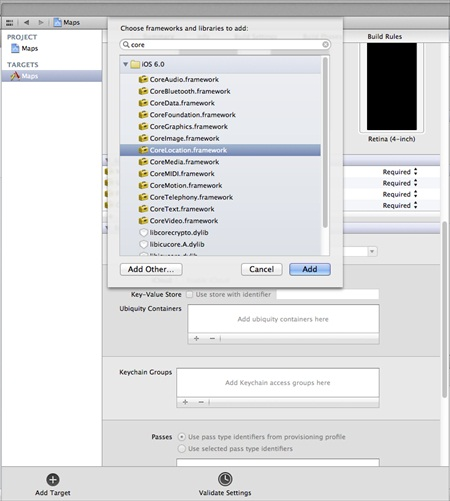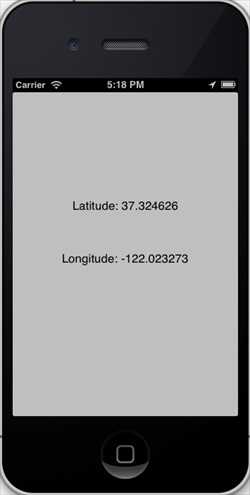iOS positioning operations
May 21, 2021 iOS Development Manual
Table of contents
IOS positioning operations
Brief introduction
In IOS, through CoreLocation positioning, the user's current position can be obtained, and the device movement information can be obtained.
The instance step
1, create a simple View base application (view application).
2, select the project file, then select the target, and then add CoreLocation.framework, as shown below

3, add two tags to ViewController.xib to create a label called latitudeLabel and longtitudeLabel
4. Now by selecting "File-gt; New-Gt; File...", select Objective Class and click Next
5, the "sub class of" as NSObject, the class named LocationHandler
6, choose to create
7, update LocationHandler.h, as shown below
#import <Foundation/Foundation.h>
#import <CoreLocation/CoreLocation.h>
@protocol LocationHandlerDelegate <NSObject>
@required
-(void) didUpdateToLocation:(CLLocation*)newLocation
fromLocation:(CLLocation*)oldLocation;
@end
@interface LocationHandler : NSObject<CLLocationManagerDelegate>
{
CLLocationManager *locationManager;
}
@property(nonatomic,strong) id<LocationHandlerDelegate> delegate;
+(id)getSharedInstance;
-(void)startUpdating;
-(void) stopUpdating;
@end
8, update the Location .m, as shown below
#import "LocationHandler.h"
static LocationHandler *DefaultManager = nil;
@interface LocationHandler()
-(void)initiate;
@end
@implementation LocationHandler
+(id)getSharedInstance{
if (!DefaultManager) {
DefaultManager = [[self allocWithZone:NULL]init];
[DefaultManager initiate];
}
return DefaultManager;
}
-(void)initiate{
locationManager = [[CLLocationManager alloc]init];
locationManager.delegate = self;
}
-(void)startUpdating{
[locationManager startUpdatingLocation];
}
-(void) stopUpdating{
[locationManager stopUpdatingLocation];
}
-(void)locationManager:(CLLocationManager *)manager didUpdateToLocation:
(CLLocation *)newLocation fromLocation:(CLLocation *)oldLocation{
if ([self.delegate respondsToSelector:@selector
(didUpdateToLocation:fromLocation:)])
{
[self.delegate didUpdateToLocation:oldLocation
fromLocation:newLocation];
}
}
@end
9, update ViewController.h, as shown below
#import <UIKit/UIKit.h>
#import "LocationHandler.h"
@interface ViewController : UIViewController<LocationHandlerDelegate>
{
IBOutlet UILabel *latitudeLabel;
IBOutlet UILabel *longitudeLabel;
}
@end
10, update the ViewController .m, as shown below
#import "ViewController.h"
@interface ViewController ()
@end
@implementation ViewController
- (void)viewDidLoad
{
[super viewDidLoad];
[[LocationHandler getSharedInstance]setDelegate:self];
[[LocationHandler getSharedInstance]startUpdating];
}
- (void)didReceiveMemoryWarning
{
[super didReceiveMemoryWarning];
// Dispose of any resources that can be recreated.
}
-(void)didUpdateToLocation:(CLLocation *)newLocation
fromLocation:(CLLocation *)oldLocation{
[latitudeLabel setText:[NSString stringWithFormat:
@"Latitude: %f",newLocation.coordinate.latitude]];
[longitudeLabel setText:[NSString stringWithFormat:
@"Longitude: %f",newLocation.coordinate.longitude]];
}
@end
Output
When we run the application, we get the following output:
